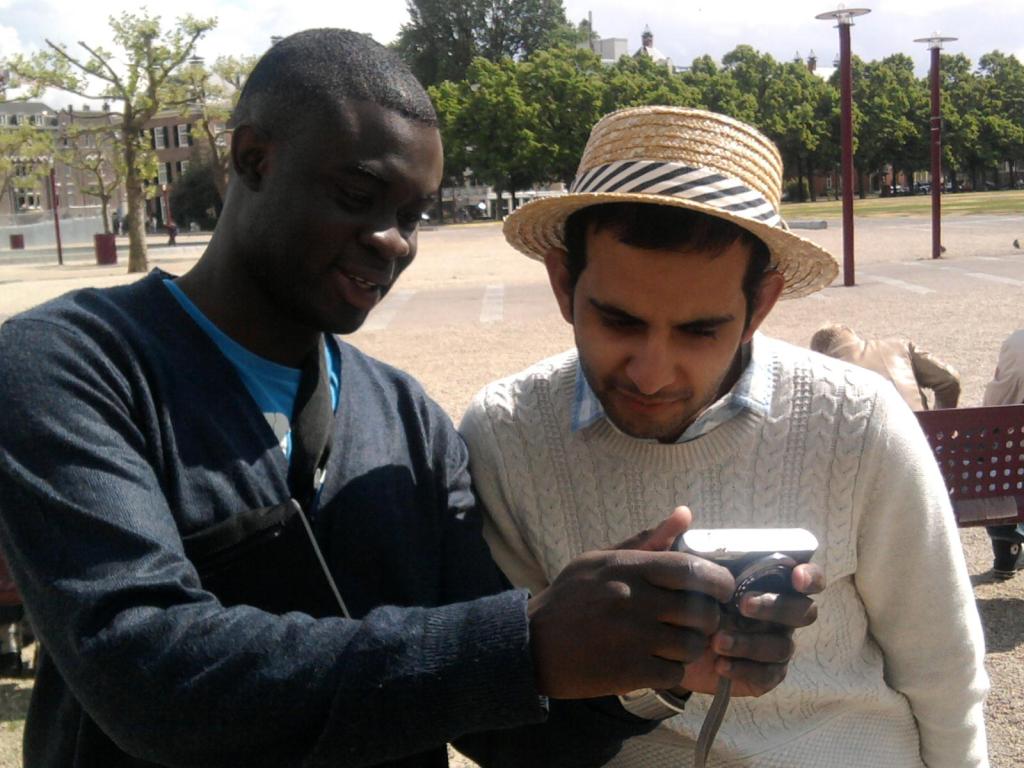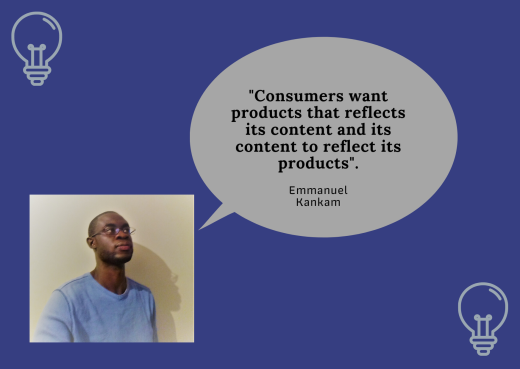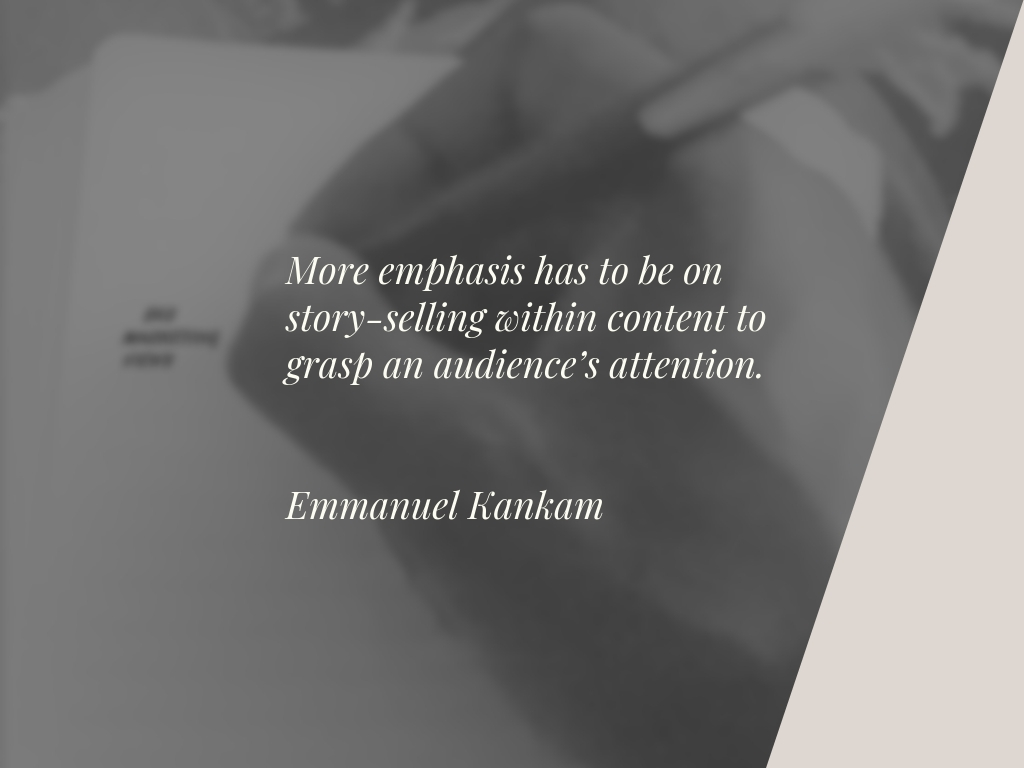
Emmanuel #EKsMarketingViews
Demonstrate

Know your brand’s story, product /service well. Capture this with content – written and visual. Show and tell helps you sell.
Educate

Inform your audience of the benefits of the product or service you provide. Want to stand out? Be visual. Capture demonstrations through video, photos, use infographics (Canva is a great tool for this).
Communicate

Don’t speak to audience using jargon or internal terminology they will not understand. Remember the principles of KISS – Keep It Simple, Stupid, Keep It Short and Simple, Keep It Simple and Straightforward.
Resonate

Create content that appeals to your target audience. Never forget who they are and their wants and needs for your product or service. Sell the need, buy the want.
Until next time…
Emmanuel #EKsMarketingViews
TikTok is the fastest-growing app. Fact. Since its emergence into the social media realm in 2016, the app has continued to grow to stratospheric heights. The short-form video hosting service which was deemed by some as just the app for Generation Z due to its dance challenges, has surpassed that. TikTok has:
While these statistics may be jaw-dropping, to say the least, why is the app so popular? According to statistics from Tiktok’s ‘Whats Next 2023 Trend Report’, 90% of users said the app makes them happy and never gets boring. Free editing tools and templates such as CapCut (which you can download on your Play Store), help make content more engaging. With the first seconds as a user, you want something that instantly grabs your attention. Does the content resonate with you? Does stir up some kind of emotion? Does it tell and sell a story? CapCut helps encapsulate all of this.
However, it is not just short-form videos that make TikTok a success. It is much more. People can buy products directly from the hosting service. Shops and people can directly sell to their viewers as illustrated below.
This helps with engagement levels. Viewers become consumers, consumers become brand advocates and loyal followers. Having the chance to communicate directly to your audience, and read and respond to comments, creates a personal touch. It makes online shopping more human.
Let me break it down for you, think of it like this. EBay is a platform that allows people and shops to sell products online directly to a consumer. TikTok’s shopping function does the same but goes the extra mile. It allows viewers to see the sellers on camera and the sellers to talk directly to their potential consumers. Direct selling; face-to-face retail but on an online platform. Kind of like the legendary shopping channels such as QVC but on a mobile app.
TikTok’s capabilities do not just stop there. You guessed it, there’s more. If you have a following of 800 or more people, you can go live.
You can talk to viewers, and build more of a following and a community. Like marketing, you are building your brand and online presence. This makes it more personal to your followers. You can also have battles with other creators and your viewers and followers can send you gifts.
TikTok is disrupting the social media realm and putting the SOCIAL in social media. People can connect and the app can be great for businesses to capitalise on and create brand awareness. Like its counterparts i.e. Twitter, Facebook, and Instagram, it has the option where businesses can use paid advertising too.
However, businesses should not just jump on the bandwagon. A clear and concise strategy has to be put into place. Does the company’s main demographic use TikTok? Can the company tap into a new audience? These are some of the questions that need to be taken into consideration.
While time may tick away, one thing is certain. Only time will tell what other capabilities the app will introduce and how other platforms will react to this.
Until next time…
Emmanuel #EKsMarketingViews
Over the last year, the world has faced many challenges. It has felt as though things had come to standstill. While some businesses have struggled, some have flourished and one medium that has continued to grow is social media. With LinkedIn introducing stories to their platform last year as another method of communication, it draws parallels to its contemporaries. With Snapchat, Instagram, Facebook, YouTube and Twitter all having a stories function, it raises the question, “Are the lines between social media becoming blurred?”
Snapchat, the pioneer of the stories function back in 2013, a narrative of snaps with a 24-hour life span that could be shared with friends became an instant hit. With more than 400 million stories created daily, the popularity of the platform hasn’t ceased. However, Instagram has become the front runner with 500 million people using Stories every day so it only makes sense that other social media platforms would want a piece of the pie figuratively speaking.
Stories resonate with people because they can provide in-the-moment content and with the narrative being 24 hours, this provides real-time that is being captured so it makes followers and viewers feel as though they are part of the story. It is also easy to use and allows users to be as creative or less creative as they want to be. It is fun and experimental.
With stories being highly consumable, it’s not just other platforms that have jumped on the bandwagon but businesses too. This can also be said about hashtags.
Hashtags were synonymous with Twitter and allowed people/consumers to find and follow the content of a specific theme. As its popularity rose, other social media platforms have incorporated this such as Facebook and Instagram – where you can use as many as 30 hashtags in one post. YouTube uses hashtags to help with the discovery of videos. Hashtags are a powerful tool.
Speaking of Youtube, this was the archetype of what see today – video marketing. Since its inception in 2005, the online video platform has grown from strength to strength. “Youtube viewers watch over 1 billion hours of video on the platform every day and generates billions of views” – YouTube, 2021. With every social media platform more or less having a video function it keeps viewers and followers engaged. Whether it’s directly on the platform, doing live videos or by using streaming services such as Restream and StreamYard on multiple platforms simultaneously, videos are a proven marketing tool in creating brand awareness. According to multinational technology conglomerate Cisco, “By 2022, online videos will make up more than 82% of all consumer internet traffic — 15 times higher than it was in 2017”.
With stories, hashtags, videos and even polls, it is understandable why some may perceive social media platforms to just being a big blur as each platform has some if not all the same components. However, what some companies have to bear in mind is that not one glove fits all. Each social media has a different demographic and businesses need to focus on who their target audience is and where they are likely to be on social media.
Not every company’s social media needs to have the same content on every page. Yes, it can create uniformity but it can also look bland from a customers perspective. I’ll elaborate. If you are a consumer and are trying to find out more about a company not just by looking at their website, you also tend to look at their social media to get a grasp of what their brand represents. Seeing the same content on every social media platform doesn’t create intrigue or interest but can actually show a lack of creativity and innovation. People want to click on each platform to find out and learn more about a company. I’ll give an example of using one piece of content but spreading it over different platforms.
If a company creates a video for example and say it’s 30 minutes long, you could create a tweet (and use specific hashtags) with a link to the video. On Instagram, you can have a clip of the video as either a story or stories or a post and have a link to the video. With LinkedIn being a business networking platform, you could perhaps give an interesting stat or fact that correlates to the video and then for the viewer to follow the link to the full video. If the link is a full video that’s directly on the companies website amalgamate it with YouTube and then when the viewer clicks on the full video they could also view it through YouTube. However to get even more engagement the video should have a short description in the section that YouTube provides and also within that description a link to all the company’s social media. What I am trying to get at is that there needs to be a strategy.
Businesses have to be strategic and creative in the way that they showcase their brand and just because a new component may arrive on a platform similar to its counterpart (which will continue to happen) doesn’t mean lines have to be blurred. It’s more of an opportunity to be experimental, know where your target audience is, put your thinking cap on and utilize content and social media in unique ways so your customers – old, new and potential will be engaged.
With everything that is going on in the world, this is an opportunity to invest in creating more brand awareness, creatively and strategically which could result in a return on investment; there is nothing blurred about that.
Until next time…
Emmanuel #EKsMarketingViews

Hi everyone! I just wanted to take some time to say thank you to my followers. Thank you for being a motivation for me to continue with my blog. Never did I imagine that I would have 100 followers and to you, I am extremely grateful. The journey has not been easy but I plan to take you with me on this ride. Also to anyone that has liked and shared my blog posts – thank you. I promise I will try to continue to deliver content and your support means the world to me. I see you and I appreciate you. Once again, thank you.
Until next time…..
Emmanuel #EKsMarketingViews

Social media can be a great platform for creating brand awareness.
It is an opportunity for businesses to stand out and be unique in all fairness.
Capturing pictures and moments are great for Instagram,
Just be aware to provide content and not just spam.
As you will notice adverts are beginning to pop up more,
However, don’t jump the bandwagon unless you can provide content a customer will want to click on to explore.
Just because a hashtag is trending,
Make sure it reflects your brand otherwise the information you provide is false, misleading and you’re pretending.
Always have a clear content plan,
Strategise the best you can.
Let your story be told,
To create engagement with customers – new potential and old.
Emmanuel #EksMarketingViews

Emmanuel #EKsMarketingViews

Emmanuel #EKsMarketingViews

Over the last few years, content marketing has become more prominent and has been at the forefront for businesses and their overall marketing strategy. With platforms and mediums such as video and social media continuing to be utilised, more content is being produced. However, what lies at the heart of making content resonate with people is story-telling and story-selling.
To be a good story-teller, you have to be a good story -seller and that helps makes content more appealing to consumers – old, new and potential. Allow me to explain.
As human beings, our brains function in a specific way. The left side of the brain is responsible for controlling the right side of the body and vice versa. However what the left side also does is performs tasks to do with logic, analysis, maths and reasoning while the right side of the brain is home to emotions and is used to perform tasks to do with creativity, art, intuition and music.
According to a global study in 2017 titled “Meaningful Brands” from Havas Group which links brand performance to our everyday lives, 84% of people expect brands to provide content that:
When telling a story, people want content that provides emotive context. However, when companies are trying to sell a product or service, they cannot just be storytellers, they need to become story-sellers. A story cannot just be told when something in business needs to be sold. This is where information, data, statistics come into place as it will connect to the left side of the brain to help justify making decisions. Statistics from the Content Marketing Institute has shown that 91% of UK marketers ensure that their content is fact-based and/or credible. This can help instil trust and brand loyalty.
To be story-seller, it is about using a combination of emotive and logical content to make people buy a product or service. Here is a hypothetical example.
“Jonathan has been saving up from the last year to try to do an advertising course (already I am providing emotional content and setting the story up) but prices were still expensive so it seemed unattainable. This year, courses currently online are offering a 40% discount (using data and taping into the logical side i.e. the intellectual side of the brain). Jonathan finds an international accredited course in advertising and is currently working towards his qualification. To find an accredited course with a 40% discount contact X”.
That is just a very rough example of using story selling and using a mixture of emotion, logic and intellect to deliver a message straight to a potential consumer to create a demand for a product or service. Story-selling is not an easy thing to do and can take time to master using information, data and creating a detailed story which comprises of the left and right hemisphere of the brain.
As the year is about to draw to a close and new one about to begin, more content will be produced and businesses should continue to tell stories but also sell them too.
Emmmanuel #EKsMarketingViews